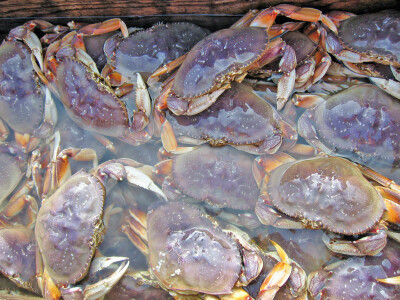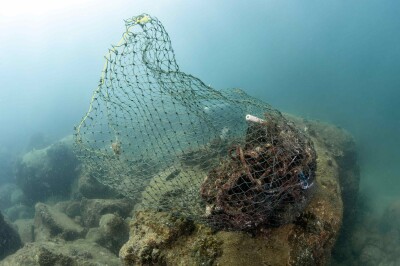NORTHEAST
A wheelchair secure tunaman; Maine lobsterman's first boat
Patrick Simmons, a Yarmouth, Maine, tuna fisherman finally got the boat he wanted. Simmons had been fishing out of a deep-V hull, a "roly-poly thing," says Bruce Farrin of Farrin's Boatshop in Walpole, Maine. Such a boat wasn't the best match for Simmons, who is disabled and operates in a wheelchair.
"He wanted a boat with a more stable platform and wanted a boat that goes good," says Farrin. That turned out to be a 34 Calvin Beal that Farrin's Boatshop started last fall and launched at the end of May. This isn't the first hull the boatyard has finished off for a disabled fisherman. Farrin completed a Wayne Beal 36 for Friendship lobsterman Danny Reed 12 years ago.
On Simmons' Kelley Anne, Farrin's shop custom built everything but the hull. Standard deck and cabin units that are available with a hull wouldn't work because Simmons is operating the boat at wheelchair level. To build the navigation station, the yard crew had Simmons sit in his wheelchair in the cabin so they could make various measurements, such as "eye level, line of sight and comfortable reaching range," says Farrin, to the controls and steering wheel.
"He has good visibility through the windows, but we kept them high enough that someone standing up can see out, too." (Simmons takes one or two people with him on his fishing trips.)
Because the Kelley Anne is a lot more stable than Simmons' previous boat, he can operate it about 80 percent of the time, as opposed to 20 percent for the deep-V boat. To help hold down his wheelchair, there's a U-shaped metal bar on the cabin sole in front of the nav station, which a bar on the front end of the wheelchair runs through. "That holds the wheelchair down and keeps it from going over backwards, and he can lock the wheels of the wheelchair," Farrin says.
When it gets too rough for that arrangement to work, "there is what we call the safety zone where Patrick can put his wheelchair. It's on the port side and in the forward corner of the day berth," Farrin says. "A special locking device keeps the wheelchair from tipping, and there are a couple of eyebolts that you can use a ratchet strap with for the wheelchair."
Out on the deck is an electric reel that Simmons uses for fishing and a 12-inch hydraulic hauler on a davit for bringing in the anchor, or pulling a tuna through the transom's tuna door. The hauler is set up with a spring-loaded valve that automatically returns to the off position, if Simmons takes his hand off it.
Using the transom door and an aluminum ramp, Simmons wheels himself from a dockside float onto the boat. A folding aluminum ramp allows him to enter the wheelhouse. Heat outlets around the wheelhouse ensure that Simmons is always in a warm spot, because quadriplegics have poor circulation.
When his boat was completed, Farrin remembers, "Patrick said, 'There are so many others out there. If they can see this, they know they just don't have to sit at home in their wheelchair.'"
In Milbridge, Allen Leighton finished off the No Monies, a Crowley 28 lobster boat for himself. He did it in the shop of his brother-in-law, Alton Wallace, who was finishing off a Crowley 36 at the same time (see "Crowley 36 gains some beam," NF Sept. '09, p. 32). "He helped me finish mine and I helped him finish his," Leighton says.
Leighton and Wallace fished together for seven years, but "we decided it was more economical for us to go on our own," Leighton says. He has also fished out of skiffs, but the No Monies is the first boat Leighton has owned.
Leighton had some boatbuilding experience when he tackled finishing off his own boat. He had worked six years for Jimmy Beal at Beal's Boat Shop in Milbridge, the same shop that built his Crowley 28 hull.
Next year Leighton is going to add two more feet to the stern. "The boat handles beautifully now, but that will allow me to carry more traps," Leighton says. "Jimmy gave me the idea. He said with two more feet she'll be a better boat," Leighton notes.
For power he has a 210-hp Cummins that is hooked up to a ZF marine gear with a 2:1 reduction, which turns a 24" x 22" wheel. That gives the boat a top speed of 22.5 knots. — Michael Crowley
WEST
A trio of skiffs gets jet power; Calif. boat carpenter is busy
Bay Welding Services in Homer, Alaska, completed a number of projects this past winter and spring. The shop built nine seine booms to be either retrofitted on existing boats or put on new seiners. The shop's crew also fabricated an aluminum tophouse for a salmon seiner.
"Guys had been putting off their upgrade plans a number of years, but there was a flood of them this year. It's kinda nice to see guys putting money back into their equipment," says Bay Welding Services' Eric Engebretsen.
At the same time, Bay Welding Services was building three aluminum seine skiffs for this year's salmon season. All three have diesels matched up to a water jet, with each jet built by different manufacturers.
Two of the seine skiffs measure 19' x 9'. One skiff has a 430-hp Cummins matched up with a 291 HamiltonJet. The other was launched with a 330-hp Cummins that powers a UJ305HT UltraJet.
The third skiff is larger at 20' x 9' 6". That gives it the necessary displacement for a 330-hp John Deere and a TJ-457HT Traktor Jet from North American Marine Jet. "The Traktor Jet has a longer housing than anything on the market and requires the extra foot to get everything in the skiff and get the balance and weights right," Engebretsen says.
This is a new model Traktor Jet that's based on the 1017HT with a 40-inch impeller that was developed for the U.S. Army's 190-foot E-craft (expeditionary warfare craft) under construction at Alaska Ship & Drydock in Ketchikan, Alaska.
The Traktor Jet in the Bay Welding Services seine skiff only has an 18-inch impeller, but with its redesigned impeller it takes double the horsepower of earlier 18-inch impellers. On its sea trials, the 20-footer hit 33.5 mph.
Jet drives are the preferred propulsion units for seine skiffs in Prince William Sound, Kodiak, Cook Inlet and Chignik, says Engebretsen. "It's what everyone wants."
In Southeast Alaska, a lot of skiffs have the shaft, rudder and prop arrangement or a steerable nozzle. "In Southeast, they have a lot heavier gear and there's more tide. They get about double the bollard pull you get out of jets," Engebretsen says.
"But here it's shallower water, not nearly the current and they have lighter gear, so they prefer the maneuverability they get from jets."
This fall Engebretsen hopes to have the three skiffs back for a performance comparison, plus a fourth one to throw into the mix. Bay Welding Services didn't build the fourth skiff, but Engebretsen says, "It has a similar design with a John Deere and a Canadian-built Whitewater jet," from Whitewater Marine Corp.
In Eureka, Calif., boat carpenter David Peterson has been busy — swamped is a better word. "I'm up to my neck in boats, and more are coming all the time," Peterson says.
Recently he has been repairing some older trollers at the Harbor District Shipyard at Fields Landing, just south of Eureka. The 40-foot double-ender Snowhite is one of those boats. She was built in 1940 and named after Walt Disney's first full-length animated color film, "Snow White and the Seven Dwarfs."
Perhaps it was a shortage of paint or the original owner's (and every one after him) idiosyncratic manner, but since the boat was launched, the name on the bow has always been one word and had just one "W."
On the Snowhite, Peterson installed a new anchor guard of jatoba, a hardwood from South America. Other times he uses ipe, another South American hardwood. "I'll probably go to straight ipe. The jatoba isn't as good as it used to be. The grain's too wide," Peterson says.
He refastened and caulked the planking above the main guard and replaced the chafing gear.
On another wooden troller, the Bell J II, Peterson put in a new purpleheart stem and replaced rotten planking under the anchor guard on the port
side with yellow cedar. He also did what he calls maintenance caulking.
The first week in August, Peterson had just finished refastening butt seams on another wooden boat, the Shirley. She also received some caulking, and the keel seam was splined.
"I splined the keel seam adjacent to the propeller with cedar spline and 5200 [a flexible sealant]. It's something I do because it is a hard to maintain area. The caulking doesn't stay in," Peterson explains. — Michael Crowley
SOUTH
Clammer has a diamond stern; brothers build an oyster boat
The annual Yorktown Watermen's Heritage Celebration with workboat races and a parade was held July 12 at the Watermen's Museum in Yorktown, Va. One of the boats featured — and a type that's hardly seen these days — was the Connie & Dot, a diamond-stern deadrise that was recently refurbished by David Rollins of Poquoson, Va.
The Rollins family has a long tradition of working the water and building boats in the Poquoson area. The late Bill Rollins operated Rollins Boatyard for years. When he passed away several years ago, his son, Will, took over the railway operation.
Besides running the railway, Will builds 16- and 18-foot wooden skiffs out of juniper for watermen and recreational buyers.
His brother, Tom, also a boatbuilder and a commercial fisherman, bought the Connie & Dot several years ago, glassed the sides and worked her in Chesapeake Bay's patent-tong clam fishery.
Then he sold her to another brother, David, who completely refurbished the 45' x 12' boat, which was built in 1948 by well-known boatbuilder Smiley Jenkins in Perrin, Va.
Jenkins built all kinds of wooden boats, but his specialty was the diamond stern. The diamond stern, also called the Poquoson stern, is pulled back to a point on what would otherwise be a flat transom. The diamond stern derives from the log canoes of the area, which had the V-shape at both the bow and stern.
The Connie & Dot was originally a contract boat that Jenkins started out building for a North Carolina commercial shrimp fisherman. The shrimper was unable to pay for the boat, so Clarence Hooper of Poquoson bought her.
Hooper was a commercial fisherman in the lucrative 1950s finfish haul-seine fishery, and the boat was worked in that fishery for nearly two decades. In the '70s she was converted to a yacht and used as a charter boat. In the '80s, she was turned into a clam boat and still works in that fishery.
Jenkins built about 30 diamond-stern boats, says David Rollins. Many of the boats ended up in the bay's patent-tong clam fishery because V-stern boats work well in following seas, and Virginia's hard-clam fishermen work out in the bay where following seas can be an issue.
David Rollins rebuilt most of the boat, including adding a new pilothouse and a self-bailing cockpit. "She's just like a brand new boat," he says.
The Connie & Dot is built with lightweight juniper, which allows the main engine, a 6-71 Detroit Diesel, to push her along easily at 14 knots. "She's light compared to most deadrise boats on the bay made out of pine and white oak," Rollins says. "She's pretty sweet right now, and there are not many diamond sterns left. She's a classic!"
Moving a little farther down Virginia's peninsula to Newport News, brothers David and Mark Moore are in the final stages of building a wooden 30' x 11' x 1' 10" oyster boat. The brothers lease oyster grounds on the James River from the state of Virginia and plan to use the boat to dredge oysters along the leased bottom.
"I got to get the painting done before the leaves start falling, or I'll have to wait until winter to finish her," says David Moore. The brothers are building their boat in the backyard under some large trees. "Years ago, all the boats were built outside under the sky. The main drawback to building outside is not having good weather to work on the boat. Most people do not realize that leaves create a problem, too."
The boat is framed out with 2 1/2" x 3 1/2" pressure-treated pine. The pine stem is also pressure treated and cut from a 6" x 6" timber. The horn-timber and keel are cut from an 8" x 8" timber and fastened with stainless steel bolts.
The sides of the hull are strip-planked juniper and are fastened to the frames with 2 1/2-inch stainless steel square-head screws. By early summer, the planking had a preliminary sanding and an oil-base primer. The hull will be finished off with West System epoxy and a layer of fiberglass.
Moore owns a metal fabrication business where he built the stuffing box and rudder. The main engine will be a 400-cubic-inch 300-hp Chrysler hooked up to a Velvet Drive marine gear with a 1:1.5 reduction. — Larry Chowning






